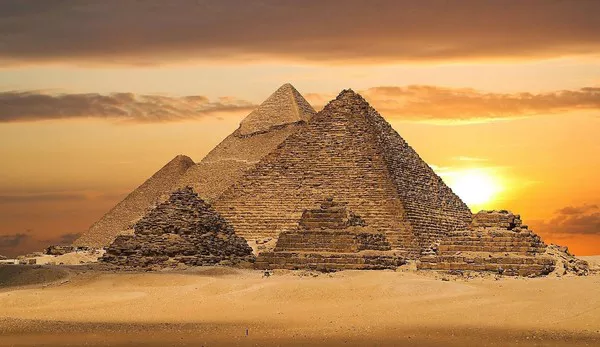Pyramids, with their grandeur and historical significance, stand as enduring symbols of human achievement and architectural prowess. From the ancient wonders of Egypt to lesser-known marvels scattered across the globe, this article delves into the top 10 largest pyramids, unraveling the mysteries and stories behind these monumental structures.
The World’s 10 Largest Pyramids
1. The Great Pyramid of Giza, Egypt:
Topping the list is the iconic Great Pyramid of Giza, a testament to the engineering brilliance of ancient Egypt. Constructed during the reign of Pharaoh Khufu, this colossal structure is the largest of the three pyramids on the Giza Plateau. Rising to a height of approximately 146 meters, the Great Pyramid held the title of the tallest man-made structure for over 3,800 years. Its construction, aligned with remarkable precision, continues to captivate researchers and archaeologists, sparking debates on the methods employed by the ancient Egyptians.
2. The Pyramid of Khafre, Egypt:
Adjacent to the Great Pyramid stands the Pyramid of Khafre, the second-largest pyramid at Giza. Although slightly smaller in height, Khafre’s pyramid appears taller due to its location on higher ground and the remnants of its original casing stones at the top. The enigmatic Sphinx guards the entrance to Khafre’s pyramid, adding an aura of mystery to this ancient marvel.
3. The Pyramid of Menkaure, Egypt:
Completing the trio of pyramids at Giza is the Pyramid of Menkaure, the smallest of the three but still an impressive structure. Constructed for Pharaoh Menkaure, this pyramid stands at around 65 meters in height. Despite its relatively smaller size, Menkaure’s pyramid is a significant part of the Giza Pyramid Complex, offering insights into the architectural evolution of ancient Egyptian pyramid building.
4. The Pyramid of Cholula, Mexico:
Stepping outside of Egypt, the Pyramid of Cholula in Mexico claims the title of the largest pyramid by volume. Although not as towering as the Giza pyramids, Cholula’s pyramid is a massive structure with a base four times larger than that of the Great Pyramid. Dedicated to the god Quetzalcoatl, this Mesoamerican pyramid is characterized by layers of construction, with each successive culture building on top of the existing structure.
5. The Great Pyramid of La Venta, Mexico:
Venturing further into Mexico, the Great Pyramid of La Venta stands as one of the largest and oldest structures in the ancient city of La Venta. Constructed by the Olmec civilization, this pyramid dates back to around 900 BCE. Though not as well-known as later Mesoamerican pyramids, La Venta’s pyramid highlights the advanced engineering skills of the Olmec people and their influence on subsequent civilizations.
6. The Pyramid of the Sun, Mexico:
Located at the ancient city of Teotihuacan, the Pyramid of the Sun is the largest structure in this Mesoamerican archaeological site. Standing at approximately 65 meters in height, this pyramid played a central role in the religious and cultural practices of the Teotihuacan civilization. The significance of the Pyramid of the Sun is further underscored by its alignment with celestial phenomena, emphasizing the importance of astronomy in Mesoamerican cultures.
7. The Pyramid of Neferefre, Egypt:
Returning to Egypt, the Pyramid of Neferefre, also known as the Pyramid of Raneferef, is part of the Abusir necropolis. While not as famous as the Giza pyramids, Neferefre’s pyramid showcases the architectural diversity of ancient Egyptian pyramid construction. The pyramid’s complex design and unique features provide valuable insights into the evolution of pyramid building techniques during the Old Kingdom.
8. The Red Pyramid, Egypt:
Situated at Dahshur, the Red Pyramid earns its name from the reddish hue of its limestone casing stones. Built by Pharaoh Sneferu, the father of Khufu, this pyramid is the third-largest in Egypt. The Red Pyramid marks a crucial phase in the development of pyramid design, showcasing advancements in construction techniques that would later influence the construction of the Great Pyramid of Giza.
9. The Pyramid of Djoser, Egypt:
Often referred to as the Step Pyramid, the Pyramid of Djoser at Saqqara is an early example of pyramid construction during the Third Dynasty of ancient Egypt. Designed by the architect Imhotep, Djoser’s pyramid is a step pyramid, featuring six mastabas stacked on top of each other. This innovative design marked a departure from traditional burial practices and laid the foundation for the evolution of pyramid architecture.
10. The Pyramid of the Magician, Mexico:
Completing our exploration of the world’s largest pyramids is the Pyramid of the Magician at the ancient city of Uxmal in Mexico. This Mayan pyramid stands out for its elliptical base and steep stairways, creating a striking visual impact. The Pyramid of the Magician reflects the architectural prowess of the Mayan civilization and its ability to create impressive structures with unique design elements.
See Also:TOP 10 SILVER PRODUCING COUNTRIES IN THE WORLD
Conclusion:
From the mystique of the Great Pyramid of Giza to the cultural richness embodied by the Pyramid of the Magician, the world’s largest pyramids tell tales of ancient civilizations, their beliefs, and their remarkable architectural achievements. As we continue to uncover the secrets of these monumental structures, the exploration of pyramids remains an ongoing journey into the past, providing valuable insights into the ingenuity and creativity of our ancestors. Each pyramid, a testament to human ambition and craftsmanship, stands as a beacon connecting us to the fascinating tapestry of our shared history.
You Might Be Interested In:






















